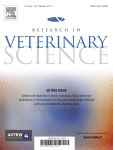Ver ítem
- xmlui.general.dspace_homeCentros e Institutos de InvestigaciónCICVyA. Centro de Investigación en Ciencias Veterinarias y AgronómicasInstituto de BiotecnologíaArtículos científicosxmlui.ArtifactBrowser.ItemViewer.trail
- Inicio
- Centros e Institutos de Investigación
- CICVyA. Centro de Investigación en Ciencias Veterinarias y Agronómicas
- Instituto de Biotecnología
- Artículos científicos
- Ver ítem
Immunohistochemical detection of pro-inflammatory and anti-inflammatory cytokines in granulomas in cattle with natural Mycobacterium bovis infection
Resumen
Cellular immune response was evaluated in lymph nodes and lung with different granulomatous lesions from cattle naturally infected with Mycobacterium bovis. For this purpose, we assessed pro-inflammatory and anti-inflammatory
cytokines by immunohistochemical assays. Immunoreaction was observed for all the cytokines analyzed.
Fourteen animals displayed advanced stage IV granulomas, with intense immunoreactivity to IFN-γ and TGF-β in areas of caseous
[ver mas...]
Cellular immune response was evaluated in lymph nodes and lung with different granulomatous lesions from cattle naturally infected with Mycobacterium bovis. For this purpose, we assessed pro-inflammatory and anti-inflammatory
cytokines by immunohistochemical assays. Immunoreaction was observed for all the cytokines analyzed.
Fourteen animals displayed advanced stage IV granulomas, with intense immunoreactivity to IFN-γ and TGF-β in areas of caseous necrosis, macrophages and lymphocytes. Seven animals showed stage III granuloma,
with high immunoreactivity to IFN-γ (average of 44.5% immunoreactive cells) and moderate to TNF-αand to the anti-inflammatory cytokines IL-10 and TGF-β, in relation to the proliferation of fibroblasts in granuloma periphery
We found satellite stage I granulomas in 4 bovines and stage II granulomas in 2 bovines, which exhibited low immunostaining response (‐13%). Cytokine expression in stage III and IV granulomas was significant, with predominance of immunoreactivity to IFN-γ, thus suggesting a strong, longstanding local immune response mediated by macrophages and epithelioid cells. In addition, these two stages displayed lower reactivity to IL-10; which suggests a deficit of anti-inflammatory cytokines, suppressed immunity and persistence of the infection.
High expression of TGF-β could indicate a chronic processwith greater tissue damage and fibrosis. Numerous bacilli observed in necrotic areas in stage III and IV granulomas with low expression of IL-1β suggest failure in the immune response with bacterial multiplication. In this study, evidence of in situ presence of cytokines demonstrates these cytokines are involved in the development and evolution of bovine tuberculosis granulomas.
[Cerrar]

Autor
Canal, Ana María;
Pezzone, Natalia;
Cataldi, Angel Adrian;
Zumarraga, Martin Jose;
Larzabal, Mariano;
Garbaccio, Sergio Gabriel;
Fernández, Analía;
Dominguez, Lucas;
Aranaz, Alicia;
Rodriguez-Bertos, Antonio;
Fuente
Research in veterinary science 110 : 34-39. (2017)
Fecha
2017
ISSN
0034-5288
Formato
pdf
Tipo de documento
artículo
Palabras Claves
Derechos de acceso
Restringido
 Excepto donde se diga explicitamente, este item se publica bajo la siguiente descripción: Creative Commons Attribution-NonCommercial-ShareAlike 2.5 Unported (CC BY-NC-SA 2.5)
Excepto donde se diga explicitamente, este item se publica bajo la siguiente descripción: Creative Commons Attribution-NonCommercial-ShareAlike 2.5 Unported (CC BY-NC-SA 2.5)

